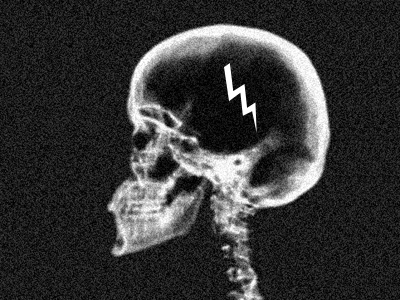Health Warning Labels Make People Want to Smoke
 A three-year, $7 million neuromarketing study done in Oxford, England has found that cigarette health warning labels actually make smokers want to smoke more, not less. Neuromarketing research studies how the brain reacts to various types of marketing stimuli. Researchers studied 2,000 people from five different countries using sophisticated brain-testing technology, like electroencephalography and magnetic resonance imaging (MRI) to gain a better understanding of consumer behavior. A surprising finding involved the health warning labels placed on cigarette packs. Researchers asked subjects if the warning labels worked to help them reduce smoking, and most said "yes." But when they repeated the same question while flashing images of the labels to the subjects while they underwent an MRI, they found that the images activated "craving spots" in the brain, indicating that the health warnings actually encourage smokers to smoke more.
A three-year, $7 million neuromarketing study done in Oxford, England has found that cigarette health warning labels actually make smokers want to smoke more, not less. Neuromarketing research studies how the brain reacts to various types of marketing stimuli. Researchers studied 2,000 people from five different countries using sophisticated brain-testing technology, like electroencephalography and magnetic resonance imaging (MRI) to gain a better understanding of consumer behavior. A surprising finding involved the health warning labels placed on cigarette packs. Researchers asked subjects if the warning labels worked to help them reduce smoking, and most said "yes." But when they repeated the same question while flashing images of the labels to the subjects while they underwent an MRI, they found that the images activated "craving spots" in the brain, indicating that the health warnings actually encourage smokers to smoke more.
- 5039 reads
 Printer-friendly version
Printer-friendly version- Add new comment
- permalink





Comments
Mixed up people and mixed up motives
"from DgsWilsonHome a reality based site that deals with addictions of all types."
"Choose a Motive"
Every day we decide, to one degree or another, what to wear based on what we want to accomplish. I was going to call this entry being effective but chose the title you see because I consider it more beneficial. It's comes closer to cause.
I'm not going to spend much time on it because it's really a simple concept and all the whys are covered in earlier writings. Choosing a motive is just like any other decision we will make in life. I used deciding what to wear because it's a good mental picture. You wouldn't wear a ball gown to fix the pipes under the house. So first we have to decide what it is we're setting out to accomplish in our lives. I have decided that my life will be spent being as useful to life as I can. The sentence contains my motive. My motive is to be useful.
Everyday I ask all of the intelligence in the universe, or the intelligence that is life, or however you choose to see it, to direct me to what is best. I sit still and open myself to whatever communion is available. My brain thinks I suck at this, I know it does because it tells me. In spite of all that goes on to make me feel I'm doing a crappy job I have steadily moved in a direction.
Its possible that the decision to be useful, then doing those things I identified as useful, has led to a channel being cleared between me and the intelligence. Probably something resembling that but words become inadequate at some point and searching too much is tiring. The crux is that motive is a key to accomplishment. There is one prime motivation that is shared by everyone. That is to be happy. There is a great deal to gain from understanding this and I suggest that it be examined fully. I'll be writing more on this because it is key to understanding the system. But for now I include it because it's going to be a factor in your personal examination and its good to be aware of it before hand. Whats happening in ones life has a direct relationship to motive. If your life is not what you would like it to be then identify your motives. Write them on paper. Concentrate on this topic until you are able to get a better picture of how things work. The system of life is like any other system, as we learn the system we get better at operating within it. We can learn a system and decide we want nothing to do with it and that is a completely legitimate decision. Finding out what the system is may well be the most important thing anyone can do.
If the goal of the reader is to get started on a self determined path then this area of motive must be examined. The first thing that needs to be done is to find out what your current motivations are. Look for where they came from. Ask if these are motivations you would suggest to some one you like. Ask questions. Write them down. They will be answered once you've got them written down. Getting good answers is all about asking good questions. All the help you may need is available. Myself, millions of others and the totality of life are here to be of service. I'm sure you have a lot to consider so I'll get out of the way. Remember to have as much fun as you can.
Cigarette? Did someone say cigarette?
As a smoker who's quit and started numerous times (currently quit) I would guess that what's happening is that even a warning label triggers the concept "cigarette" in the brain. And that symbol is so tied to craving that anything attached to it is just the tail on the kite. If someone told me, "Your mother just died of cancer from smoking," I bet an fMRI would light up in the part of my brain that triggers a desire for nicotine.
BackFired
I wonder if it has anything to do with nag burnout. Many people are getting tired of government constantly nagging. There is a hidden resentment that makes people want to do the opposite.
Warning Labels
They performed an MRI while the subjects were shown the warning labels? One would venture to suggest that there was a standard 'No Smoking' rule in the Lab/Clinic, and assuming an interview or prep process took place in advance of the test, it is likely that the subject had in fact not smoked for at least 15-20 minutes by the time the MRI took place.
Then you show them a portion of a cigarette pack and think that any observed reaction will be because of the warnings???
Methinks that not even pseudo-science is in play here! I've seen more credible oedipal studies!
Well not really, but you know...
Graphic warning labels seem more effective
In December 2000, Canada instituted [http://tobacco.health.usyd.edu.au/site/supersite/resources/docs/gallery_packwarnings.htm graphic warning labels] on cigarette packs to fulfill a requirement of the [[Framework Convention on Tobacco Control]], or Global Tobacco Treaty (which the U.S. has signed but never ratified under the [[Bush Administration]]). The photos take up 50% of the face of the pack. Photos included pictures of people with tracheostomies, amputated limbs resulting from circulatory problems, gum disease and premature babies on life support equipment. An August, 2004 [http://www.ajph.org/cgi/content/full/94/8/1442 article] in the American Journal of Public Health examined the effectiveness of these health warnings and found that about one fifth of study participants reported that they started smoking less as a result of these more graphic warning labels and only 1% reported smoking more. 30% of people tried to cover them up (and were not counted in the results of the study).
Anne Landman
Tobacco Warnings as Ads
I agree that the title is a bit overblown... Presumably, any element of the packaging that is consistent over time would become a craving trigger - even warnings! I wrote about this in more detail in Are Tobacco Warnings Really Ads?
An interesting study would be to see the effect of these warnings on those who are not yet regular smokers. Perhaps bold warnings or gruesome disease photos would have the expected scary effect.
Roger
Neuromarketing
Doubtful conclusions
I'm pretty sure the author of that book is misstating the results of the study. It seems far more likely to me that showing a smoker a piece of cigarette packaging makes them want to smoke, period. It doesn't sound like they compared cigarette packages with and without warning labels.